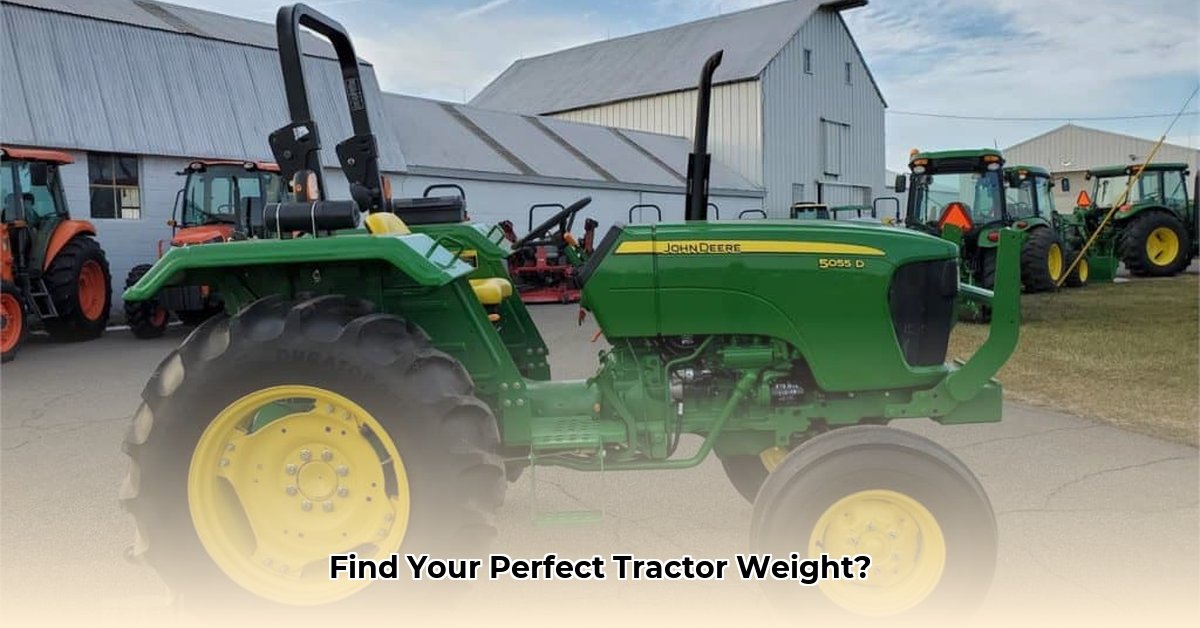
Choosing the right tractor is a significant investment, impacting farm efficiency and profitability. One crucial factor often overlooked is weight. This comprehensive guide explores tractor weight, its implications, and how to select the ideal size for your operation. For example, see more information on classic tractor weights like the Ford 8N.
Understanding Tractor Weight and Its Impact
Tractor weight isn't simply a number; it's a critical factor influencing performance, operating costs, and soil health. Heavier tractors generally offer superior power and traction, excelling in challenging conditions like hilly terrain or heavy soil. But increased weight comes at a cost: higher fuel consumption, more wear and tear, and potentially increased soil compaction. Let's delve into the key considerations.
Power and Performance
Heavier tractors typically boast higher horsepower, enabling them to tackle demanding tasks such as plowing tough fields or hauling heavy loads. This relationship between weight and power is crucial. A heavier machine, like a John Deere 8R series, is built for large-scale operations, while a lighter model, such as a Kubota BX series, is ideal for smaller tasks. "The weight directly correlates to the machine's capacity," explains Dr. Emily Carter, Agricultural Engineering Professor at Purdue University. "A heavier tractor offers more stability and power for larger tasks, while a lighter tractor is better suited for precision work in tighter spaces."
Stability and Traction
Weight plays a pivotal role in stability and traction. Heavier tractors provide superior grip, especially in muddy or hilly conditions. This enhanced traction minimizes wheel slippage, ensuring efficient operation and preventing costly delays. "Think of it like driving in snow," adds Dr. Carter. "More weight means more contact with the ground, providing better traction and control." However, excessive weight can lead to soil compaction, negatively impacting long-term soil health.
Maneuverability and Operational Costs
While weight offers advantages in power and stability, it compromises maneuverability. Heavier tractors are less agile in confined spaces and require more space to turn. Furthermore, heavier tractors generally translate to higher operating costs, including increased fuel consumption, more frequent maintenance, and potentially higher insurance premiums. "Fuel efficiency is a major concern," notes Mark Olsen, Farm Manager at Green Valley Farms. "A heavier tractor burns more fuel, which significantly impacts profitability over time."
Choosing the Right Tractor Weight: A Step-by-Step Guide
Selecting the appropriate tractor weight demands a careful assessment of your specific needs. Here's a step-by-step guide to help you make an informed decision:
Assess Your Farming Operation: Identify your primary tasks (e.g., plowing, planting, harvesting). This determines the required horsepower and, consequently, the appropriate tractor weight.
Evaluate Your Land: Consider soil type (clay, sandy, loam), terrain (hilly, flat), and field size. This factors directly into your traction and stability needs.
Determine Required Horsepower: Match the horsepower to the intensity and scale of your tasks. Generally, heavier tractors possess higher horsepower.
Establish Your Budget: Factor in not only the initial purchase price but also ongoing costs, such as fuel, maintenance, and repairs, which often scale with tractor weight.
Research Tractor Models: Compare models from various manufacturers, paying attention to weight, horsepower, features, and reviews. Consider manufacturers such as John Deere, Kubota, and New Holland.
A Practical Guide to Weight Management
Optimizing tractor weight goes beyond simply selecting the right machine. Strategic weight management can enhance efficiency and minimize negative environmental impacts. We will cover this in the following section.
Understanding the Weight Game - The Importance of Ballast
The weight of a tractor isn't solely determined by its chassis and engine. Additional ballast—weights strategically added to increase traction and stability—significantly influences total weight. These can include front-end loaders, suitcase weights, or liquid ballast in the tires.
Optimizing Ballast for Your Soil and Terrain
Different soil types and terrain conditions require different weight management strategies. Heavier tractors and additional ballast are often necessary for heavier clay soils to prevent slippage and compaction. Lighter tractors might suffice on well-drained sandy soils. Similarly, hilly terrain necessitates more weight for stability compared to flat fields.
Ballast Strategies: A Comparative Analysis
| Strategy | Advantages | Disadvantages |
|---|---|---|
| Heavier Tractor | Superior traction, stability, and power. | Increased soil compaction, higher fuel consumption, and greater environmental impact. |
| Ballast Systems (Front/Rear) | Adjustable weight for optimized traction; cost-effective solution. | Requires careful management to ensure even weight distribution; adds complexity. |
| Lighter Tractors | Reduced soil compaction and improved fuel economy. | Might lack sufficient traction in challenging conditions. |
Key Considerations for Choosing the Right Weight
Remember, finding the optimum tractor weight is a balancing act. Too much weight contributes to soil compaction and higher operating costs. Too little, and you risk insufficient traction and reduced efficiency. Regular soil testing and careful monitoring of your tractor's performance are crucial for making informed adjustments.
By carefully considering these factors and following the steps outlined above, you can select the most appropriate tractor weight for your farm, maximizing productivity while minimizing environmental impact and optimizing profitability.